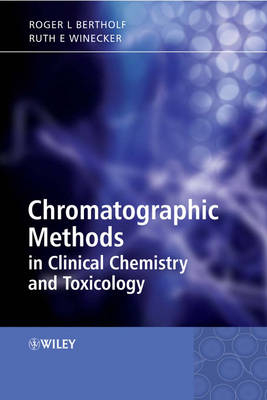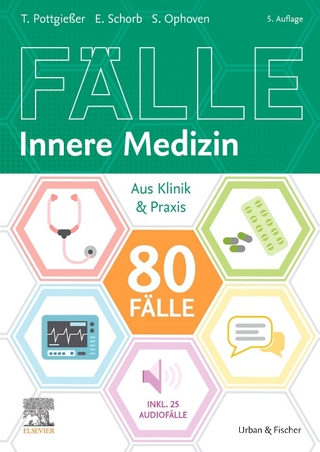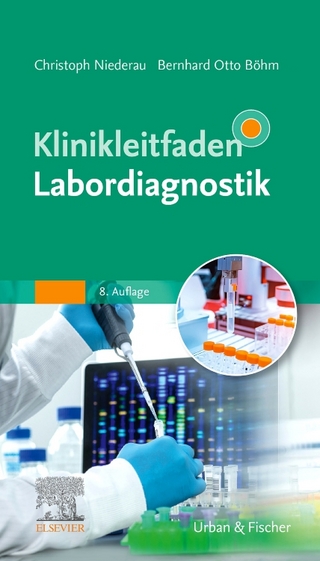
Chromatographic Methods in Clinical Chemistry and Toxicology
John Wiley & Sons Inc (Verlag)
978-0-470-02309-9 (ISBN)
This book aims to fill the gap that exists between theoretical treatments of chromatography, and clinical chemistry and toxicology texts, which focus almost exclusively on clinical relevance and applications. Chromatography has a vast array of clinical applications, and though the chromatographic methods were first introduced decades ago, new applications of this technology are being used to explore previously inaccessible frontiers in clinical diagnostics and toxicological testing. An up-to-date book devoted to clinical and toxicological applications of chromatographic methods will serve as an instructional and reference text, useful to students, laboratory technicians, and researchers.
Editors ROGER L BERTHOLF, Ph.D., DABCC, Department of Pathology, University of Florida Health Science Center, Jacksonville, FL, USA RUTH E WINECKER, Ph.D., DABFT, North Carolina Office of the Chief Medical Examiner, Chapel Hill, NC, USA
Preface xi
List of Contributors xiii
1. Quality Assurance, Quality Control and Method Validation in Chromatographic Applications 1
Michele L. Merves and Bruce A. Goldberger
1.1 Introduction 1
1.2 History 1
1.3 Definition of Quality Assurance and Quality Control 3
1.4 Professional Organizations 4
1.5 Internal Quality Assurance and Control 5
1.5.1 Standard operating procedure manual 5
1.5.2 Method development 5
1.5.3 Method validation 6
1.5.4 Accuracy 7
1.5.5 Precision 7
1.5.6 Recovery 7
1.5.7 Lower limits of detection (sensitivity) and quantitation 8
1.5.8 Range of linearity 8
1.5.9 Specificity 9
1.5.10 Stability 9
1.5.11 Carryover 9
1.5.12 Ruggedness 9
1.5.13 Selection of a reference standard 10
1.5.14 Selection of an internal standard and standard addition 10
1.5.15 Selection of derivatization agent 10
1.5.16 Selection of ions for selected-ion monitoring or full-scan analysis 11
1.5.17 Chromatographic performance 11
1.5.18 Statistical evaluation of quality control 11
1.6 External Quality Assurance 13
References 13
2. Liquid Chromatographic-Mass Spectrometric Measurement of Anabolic Steroids 15
Don H. Catlin, Yu-Chen Chang, Borislav Starcevic and Caroline K. Hatton
2.1 Introduction 15
2.2 LC-MS Analysis of Synthetic Steroids or Animal Samples 16
2.3 LC-MS Analysis of Natural Androgens in Human Samples 19
2.4 Conclusion 29
References 29
3. High-performance Liquid Chromatography in the Analysis of Active Ingredients in Herbal Nutritional Supplements 33
Amitava Dasgupta
3.1 Introduction 33
3.2 St John’s Wort 35
3.2.1 Drug interactions with St John’s wort 35
3.2.2 Measurement of active ingredients of St John’s wort using HPLC 36
3.2.3 Analysis of St John’s wort extract with other analytical techniques 38
3.2.4 Measurement of hypericin and hyperforin in human plasma using HPLC 38
3.3 Herbal Supplements with Digoxin-like Immunoreactivity 39
3.3.1 Use of HPLC for the determination of chan su, danshen and ginsengs 40
3.4 Herbal Remedies and Abnormal Liver Function Tests 41
3.4.1 Use of GC-MS and HPLC for the measurement of active components 43
3.5 Ginkgo Biloba 43
3.5.1 Analysis of components of ginkgo biloba by HPLC 44
3.6 Echinacea 45
3.6.1 Analysis of active components of echinacea by HPLC 45
3.7 Valerian 46
3.7.1 Analysis of components of valerian by HPLC 46
3.8 Feverfew 46
3.8.1 Analysis of parthenolide by HPLC 47
3.9 Garlic 47
3.9.1 Measurement of components of garlic by HPLC 48
3.10 Ephedra (Ma Huang) and Related Drugs 48
3.10.1 Analysis of active components of ephedra-containing products 49
3.11 Conclusions 50
References 50
4. Measurement of Plasma L-DOPA and L-Tyrosine by High-Performance Liquid Chromatography as a Tumor Marker in Melanoma 56
Thierry Le Bricon, Sabine Letellier, Konstantin Stoitchkov and Jean-Pierre Garnier
4.1 Introduction 56
4.2 Melanogenesis 57
4.2.1 Overview of the pathway 57
4.2.2 Potential tumor markers 58
4.3 L-DOPA Alone 59
4.3.1 Urine analysis 59
4.3.2 Blood (plasma or serum) analysis 59
4.4 L-DOPA/L-Tyrosine Ratio 60
4.4.1 Technical aspects 60
4.4.2 Clinical results 61
4.4.3 Future directions 63
4.5 Conclusion 64
References 65
5. Hypersensitive Measurement of Proteins by Capillary Isoelectric Focusing and Liquid Chromatography-Mass Spectrometry 67
Feng Zhou and Murray Johnston
5.1 Introduction 67
5.2 A Robust CIEF-RPLC Interface 69
5.3 First-Generation CIEF-RPLC-MS System for Proteins 71
5.4 Second-Generation CIEF-RPLC-MS System 76
5.5 Future Improvements 83
Acknowledgment 83
References 83
6. Chromatographic Measurement of Transferrin Glycoforms for Detecting Alcohol Abuse and Congenital Disorders of Glycosylation 87
Anders Helander
6.1 Introduction 87
6.2 Transferrin Microheterogeneity 88
6.3 Carbohydrate-deficient Transferrin (CDT) 89
6.4 Congenital Disorders of Glycosylation (CDG) 89
6.5 Analytical Methods for Transferrin Microheterogeneity 90
6.6 Chromatographic Methods for CDT 91
6.6.1 HPLC conditions and potential interferences 91
6.6.2 Chromatographic separation of transferrin glycoforms 92
6.6.3 Genetic transferrin variants and glycoform types 94
6.6.4 Sensitivity and reproducibility 94
6.7 Chromatographic Methods for CDG 94
6.7.1 HPLC testing for CDG 95
6.7.2 LC-MS testing for CDG 95
6.8 Summary and Conclusions 96
References 97
7. Chromatographic Measurements of Catecholamines and Metanephrines 101
Eric C. Y. Chan and Paul C. L. Ho
7.1 Background 101
7.1.1 Total or individual assays 104
7.2 Analytical Measurements of Catecholamines and Metanephrines 105
7.3 Early Methods 105
7.3.1 Catecholamines 105
7.3.2 Metanephrines 106
7.4 Current Chromatographic Methods 106
7.4.1 Chemistry of catecholamines 106
7.4.2 Specimen preparation 107
7.4.3 Fluorescence detection 109
7.4.4 Electrochemical detection 110
7.4.5 Chemiluminescence detection 112
7.4.6 Mass spectrometry 115
7.5 Practical Considerations for the Stability of Urinary Catecholamines and Metanephrines During Storage 117
7.6 Future Developments 118
Dedication 119
References 119
8. Chromatographic Measurement of Volatile Organic Compounds (VOCs) 127
Larry A. Broussard
8.1 Introduction 127
8.2 General Considerations 127
8.3 Intended Use 128
8.4 Volatility of Compounds 128
8.5 Sample Collection, Handling and Storage 129
8.6 Headspace Gas Chromatographic Methods 129
8.7 Columns and Detectors 130
8.8 Identification, Quantitation and Confirmation 130
8.9 Ethanol and Other Volatile Alcohols 131
8.10 Inhalants and Screening for Multiple VOCs 132
8.11 Interpretation 134
8.12 Conclusion 136
References 136
9. Chromatographic Techniques for Measuring Organophosphorus Pesticides 139
H. Wollersen and F. Musshoff
9.1 Introduction 139
9.2 Organophosphorus Pesticides (OPs) 141
9.2.1 Mechanism of action 141
9.2.2 Intoxication 141
9.2.3 Progression of intoxication and longer term risks 145
9.2.4 Therapy 146
9.2.5 Analytical procedures 146
9.3 Conclusion 163
References 164
10. Chromatographic Analysis of Nerve Agents 170
Jeri D. Ropero-Miller
10.1 Introduction 170
10.2 Neuromuscular Blockers 170
10.2.1 Background and uses 170
10.2.2 Classification, mechanism and duration of action 171
10.2.3 Effects and toxicity 173
10.2.4 Analysis 173
10.3 Paralytic Shellfish Poisoning: Saxitoxin 185
10.3.1 Background 185
10.3.2 Toxicity 187
10.3.3 Analysis 188
10.4 Summary 191
References 195
11. History and Pharmacology of c-Hydroxybutyric Acid 197
Laureen Marinetti
11.1 Introduction 197
11.2 History of Illicit Use of GHB 198
11.3 Clinical Use of GHB in Humans 200
11.4 History of Illicit Use of GBL and 1,4BD 200
11.5 Distribution and Pharmacokinetics of GHB, GBL and 1,4BD 202
11.6 GHB Interpretation Issues and Post-mortem Production 204
11.7 Analysis for GHB, GBL and 1,4BD 208
References 213
12. Liquid Chromatography with Inductively Coupled Plasma Mass Spectrometric Detection for Element Speciation: Clinical and Toxicological Applications 217
Katarzyna Wrobel, Kazimierz Wrobel and Joseph A. Caruso
12.1 Introduction 217
12.2 Liquid Chromatography with Inductively Coupled Plasma Mass Spectrometric Detection 218
12.3 Analytical Applications of Clinical and Toxicological Relevance 219
12.3.1 Arsenic 219
12.3.2 Iodine 234
12.3.3 Mercury 234
12.3.4 Platinum 240
12.3.5 Selenium 245
12.4 Conclusions and Future Trends 260
12.5 Abbreviations 260
References 262
13. Applications of Gas Chromatography-Mass Spectrometry to the Determination of Toxic Metals 274
Suresh K. Aggarwal, Robert L. Fitzgerald and David A. Herold
13.1 Introduction 274
13.2 Instrumentation 275
13.3 Experimental Procedure 276
13.3.1 Preparation of internal standard solutions 276
13.3.2 Digestion of biological sample 276
13.3.3 Preparation of metal chelate 277
13.4 GC-MS Studies 278
13.4.1 Memory effect evaluation 278
13.4.2 Precision and accuracy in measuring isotope ratios 281
13.4.3 Results of concentration determination of toxic metals in biological samples 283
13.5 Conclusions 284
References 284
Index 287
| Erscheint lt. Verlag | 1.3.2007 |
|---|---|
| Verlagsort | New York |
| Sprache | englisch |
| Maße | 175 x 246 mm |
| Gewicht | 658 g |
| Themenwelt | Studium ► 2. Studienabschnitt (Klinik) ► Anamnese / Körperliche Untersuchung |
| Studium ► 2. Studienabschnitt (Klinik) ► Pharmakologie / Toxikologie | |
| Naturwissenschaften ► Biologie ► Biochemie | |
| Naturwissenschaften ► Chemie ► Analytische Chemie | |
| ISBN-10 | 0-470-02309-0 / 0470023090 |
| ISBN-13 | 978-0-470-02309-9 / 9780470023099 |
| Zustand | Neuware |
| Haben Sie eine Frage zum Produkt? |
aus dem Bereich


